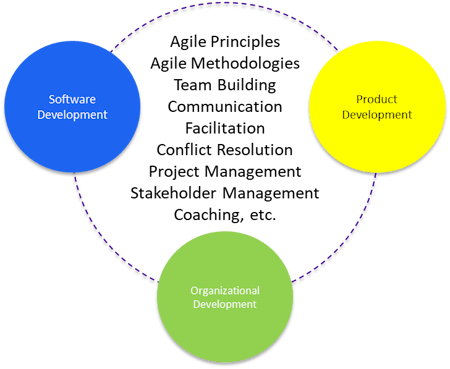Scrum Master Knowledge Areas
Agile is about iteratively collaborating (Organizational Development) with the customer or end-user, adapting to build the right thing (Product Development) in the right way (Software Development).
To be an effective Scrum Master, you need expertise in these three areas to guide teams toward high performance and sustainable agility.
- Software Development: Understanding software engineering principles, technical workflows, and team dynamics helps facilitate collaboration between developers, testers, and business stakeholders.
- Product Development: Knowledge of product strategy, value delivery, and customer needs ensures that teams align their work with business goals and user expectations.
- Organizational Development: Driving agility beyond the team level requires an understanding of change management, leadership dynamics, and organizational agility.
These areas of expertise inform the skills you use to guide and grow your team with.

However, understanding Agile alone isn't enough. You also need the right frameworks and principles to navigate complexity, optimize decision-making, and foster continuous improvement.
This is where Agile Laws come into play. Agile won't solve all your problems, but it will make them visible, and Agile Laws help you understand and address them.
To support this, AgileLaws.com organizes principles across knowledge areas that reflect the real-world challenges of Agile practice: collaboration, estimation, systems thinking, uncertainty, product behavior, continuous improvement, and organizational change. This structure helps teams discover the patterns and insights most relevant to their needs.
Scrum Masters who guide teams effectively understand that agility happens at the intersection of multiple disciplines. Software Development principles explain how systems behave under pressure, where bottlenecks emerge, and why simple code can be surprisingly hard to maintain. Laws like Wirth's Law, Lehman's Laws of Software Evolution, and Little's Law help coaches anticipate slowdowns and design for flow. Kingman's Formula, the Ninety-Ninety Rule, and the Theory of Constraints offer deeper models for managing tradeoffs in delivery and technical debt.
Product Development demands sharp prioritization and a deep understanding of what customers truly value. Laws such as the Kano Model, Pareto Principle, Golden Circle, and Law of Triviality sharpen the conversation around what to build and why. Mental models like Simon's Satisficing Principle, Miller's Law, and the Zeigarnik Effect help teams frame decisions in terms of behavior, engagement, and cognitive load. And Shalloway's Law of Requirements reminds us that clarity isn't optional.
At scale, Organizational Development is where agility succeeds or quietly erodes. Laws like Conway's Law, Larman's Laws, and Martec's Law explain how structures shape outcomes and how teams absorb or resist change. Frameworks such as Kotter's 8 Steps, ADKAR, and the Satir Change Model provide pathways for sustainable transformation. Systemic thinkers will also find value in Ashby's Law, Second-Order Cybernetics, and Deming's 94/6 Principle, which reinforce the reality that many problems are rooted in the system, not the people.
Building on that foundation, Agile Laws provide additional guidance for systemic thinking and business agility. Goodhart's Law warns against using metrics without understanding their behavioral impact. The PDCA cycle reinforces continuous improvement through inspection and adaptation. And laws like Conway's and Larman's, already visible in team structures, echo throughout attempts to scale Agile across the organization.
Frameworks like the Cynefin Framework and the Adapted Stacey Matrix help Scrum Masters determine the right approach for different levels of uncertainty and complexity. Denning's Agile Laws reinforce the importance of iteration, feedback, and adaptability, while principles like Ziv's Law remind us that uncertainty is inevitable in software development.
When it comes to team dynamics and efficiency, Agile Laws provide critical insights. Brooks' Law warns against the dangers of adding people to a late project, while Parkinson's Law highlights how work expands to fill the available time, reinforcing the need for sustainable pacing and timeboxing. Little's Law and Hofstadter's Law help teams optimize workflow and manage delays more effectively.
Ultimately, Agile Laws provide Scrum Masters with a mental model for making better decisions, managing complexity, and fostering adaptability. By leveraging these principles, Scrum Masters enhance team agility, improve collaboration, and drive true organizational transformation.
Business Agility, the ability to create and respond to change, is unlocked by applying Agile correctly. Agile Laws act as a compass, ensuring that organizations don't just "do Agile" but truly become Agile in their thinking and execution.
The more clearly you see, the more skillfully you can respond.
"If I have seen further, it is by standing upon the shoulders of giants."